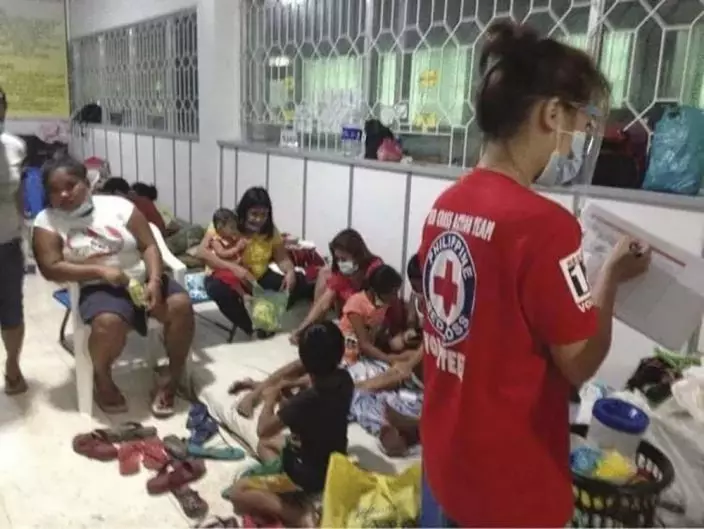A super typhoon slammed into the eastern Philippines with “catastrophic violent winds” early Sunday and about a million people have been evacuated in its projected path, including in the capital where the main international airport has been ordered closed, officials said.
Typhoon Goni hit the coast of the island province of Catanduanes at dawn with sustained winds of 225 kilometers (140 miles) per hour and gusts of 280 kph (174 mph). It was blowing westward toward densely populated regions, including Manila, and rain-soaked provinces still recovering from a typhoon that hit a week ago and left at least 22 dead, the Philippine weather agency said.
“Within the next 12 hours, catastrophic violent winds and intense to torrential rainfall associated with the region of the eyewall and inner rain bands of the typhoon will be experienced,” the agency said in an urgent advisory.

In this handout photo provided by the Philippine Red Cross, families stay at a temporary evacuation center at Catanduanes province, eastern Philippines, Sunday, Nov. 1, 2020, as Typhoon Goni hits the country. Families living near coastal towns have moved to evacuation centers as the strong typhoon makes landfall. (Philippine Red Cross via AP)
It said Catanduanes and four other provinces will be first hit, including Albay, where tens of thousands of villagers have been moved to safety, especially near the active Mayon volcano, where mudflows have caused deaths during past storms. Residents have been warned of likely landslides, massive flooding, storm surges of more than 5 meters (16 feet) and ferocious wind that can blow away shanties.
One of the most powerful typhoons in the world this year, Goni has evoked memories of Typhoon Haiyan, which left more than 7,300 people dead and missing, flattened entire villages, swept ships inland and displaced more than 5 million in November 2013 in the central Philippines.
Ricardo Jalad, who heads the government’s disaster-response agency, said nearly a million people have been preemptively moved into emergency shelters, mostly schools and government buildings. He warned of storm surges that could inundate coastal villages, including in Manila Bay.

In this handout photo provided by the Philippine Red Cross, a woman is checked at a temporary evacuation center at Catanduanes province, eastern Philippines, Sunday, Nov. 1, 2020, as Typhoon Goni hits the country. Families living near coastal towns have moved to evacuation centers as the strong typhoon makes landfall. (Philippine Red Cross via AP)
“There are so many people who are really in vulnerable areas,” Jalad told an online video news conference Saturday. “We’re expecting major damage.”
Forecasters said the typhoon’s eye may hit or graze metropolitan Manila, the densely populated capital region of more than 13 million, late Sunday to early Monday and asked the public to brace for the worst. The typhoon may considerably weaken after it hits the Sierra Madre mountain range, then cross the main northern Luzon island toward the South China Sea.
Manila’s main airport was ordered shut down for 24 hours from Sunday to Monday and airlines canceled dozens of international and domestic flights. The military and national police, along with the coast guard and firefighters, have been put on full alert.
About 1,000 COVID-19 patients were moved to hospitals and hotels from tent quarantine and treatment centers in the capital and the northern province of Bulacan, Jalad said. More emergency shelters would be opened than usual to avoid congestion that can rapidly spark infections.
The war-like typhoon preparations will further strain government resources, which have been drained with months of coronavirus outbreaks that prompted the government to set up isolation and treatment centers when hospitals were overwhelmed and provide aid to more than 20 million poor Filipinos.
The Philippines has reported more than 380,000 confirmed COVID-19 cases, the second-highest in Southeast Asia, with 7,221 deaths.
Displaced villagers may have to stay longer in evacuation centers even after Goni exits Tuesday due to another storm brewing in the Pacific that may affect the Philippines in a few days, Jalad said.
The Philippines is lashed by about 20 typhoons and storms a year. It’s also located in the so-called Pacific “Ring of Fire,” a seismically active region around the Pacific where earthquakes and volcanic eruptions are common and makes the impoverished Southeast Asian nation of more than 100 million people one of the world’s most disaster-prone.
Associated Press journalists Aaron Favila and Joeal Calupitan contributed to this report.


